
Bob Berzins is a campaigner and activist. His novel Snared is available now.
His previous guests blogs here all focus on the management, or mismanagement of upland areas such as the Peak District, Walshaw Moor and the North York Moors.
Natural England: Failure to assess and monitor Protected Sites means we all pay
Most Pennine upland areas are designated as protected sites and in the northern part of the Peak District this means the South Pennines Special Protection Area for birds, Special Area of Conservation for habitat and the Dark Peak Site of Special Scientific Interest: these are the highest levels of conservation protection that we have.
Natural England has a role to monitor and protect these sites but officers rarely get out on the ground and even when obvious breaches in regulations are discovered there’s almost never any action. I’ll talk about two current issues where monitoring and evaluation is vital.
First of all, many grouse shoots have suffered three years of poor breeding success and this has led to diversification into Red Legged Partridge and Pheasant shooting. The Wild Justice legal action has resulted in the proposal to put RLP and Pheasant onto Schedule 9 of the Wildlife and Countryside Act which means they cannot be released except under licence and special consideration must be given to protected sites, which I take to mean an Individual Licence would have to be issued. Almost all the land on grouse moors has protected status such as this shooting station and Pheasant release pen at Moscar which is SPA, SAC and SSSI:

This second photo of a grain feeder gives an indication of the habitat that Pheasant now occupy and there’s a clear overlap with native moorland birds. How can Natural England assure us native wildlife is not being harmed?

Large numbers of factory-farmed, non-native birds are having a significant effect on these conservation sites but on past performance Natural England will be more concerned with protecting the commercial interests of these Estates rather than protecting conservation. As long as the species listed under the SPA are not obviously being damaged (eg Merlin and Golden Plover) then licences will be granted. I hope I’m wrong.
A bit further north at Woodhead a Red Legged Partridge shoot has been created on protected land just behind The Lodge and a surfaced shooting track runs up Stable Clough:
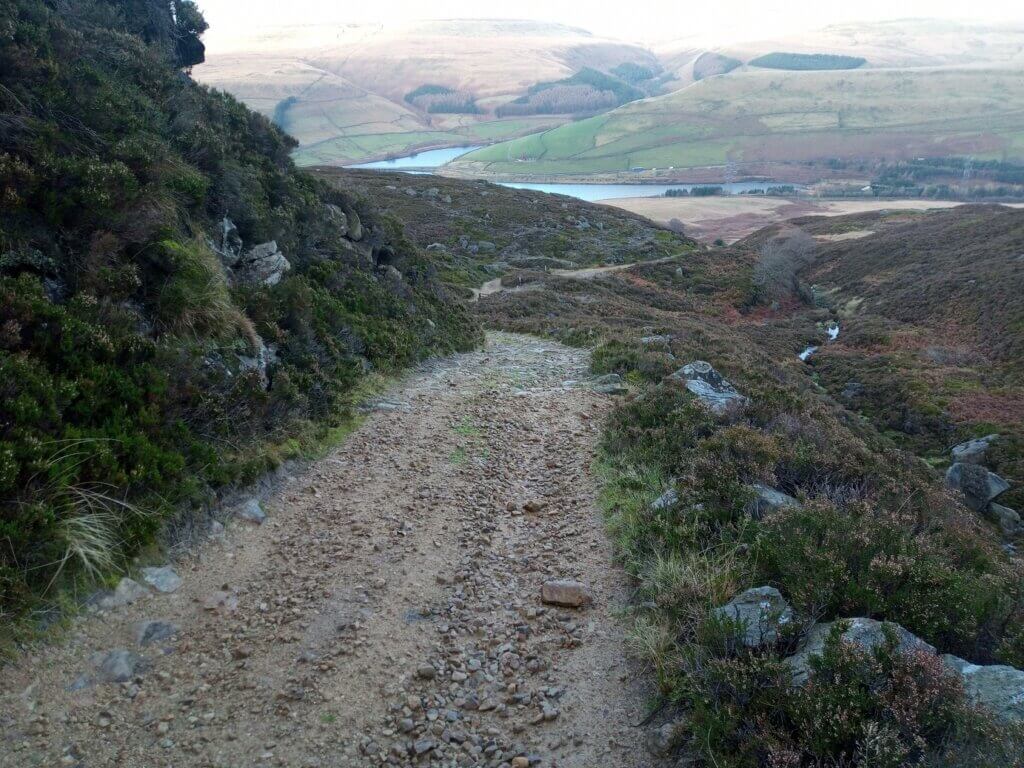
The track was subject to dispute but has remained. The construction of this track has enabled a huge area of shooting infrastructure to be created at the track end with shooting butts and unsurfaced, eroded vehicle routes in every direction and it’s a similar story at Black Cabin a couple of miles away. The erosion starts immediately above the car parks:
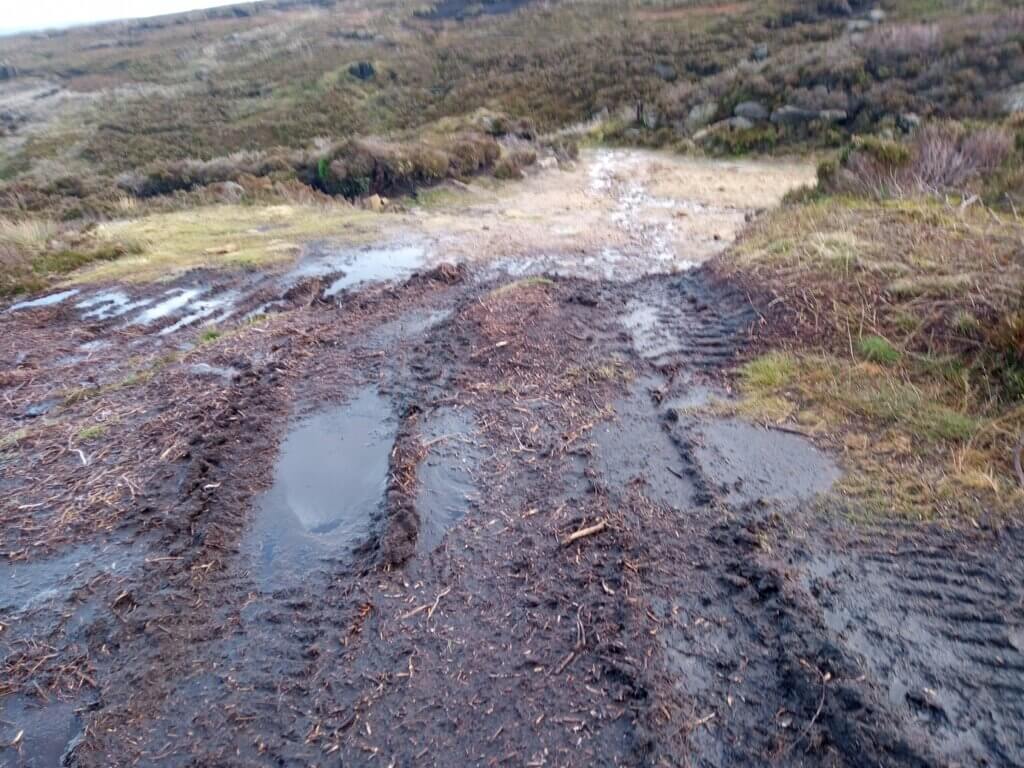
This area is subject to a large restoration project run by Moors for the Future and United Utilities, I don’t have an exact figure but the cost will be hundreds of thousands. The project has been ongoing for nearly 10 years and the initial aim was to ensure there is no bare peat. But as usual anything related to shooting activity is overlooked.
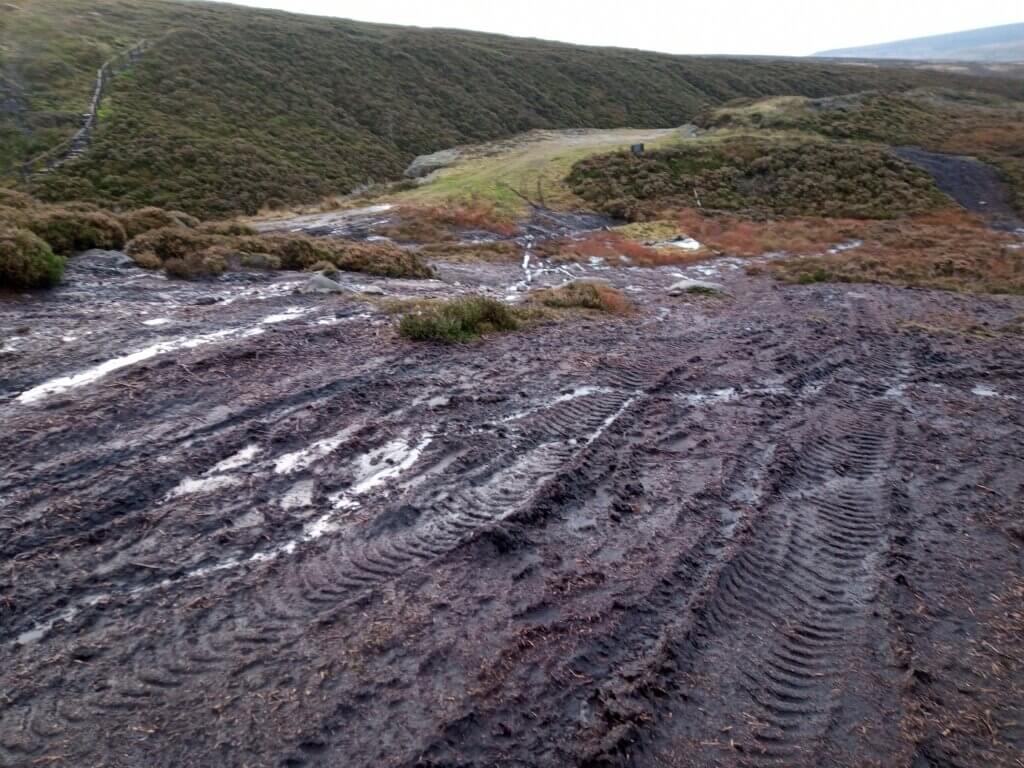
The reason United Utilities are involved is because water quality is categorised as “At Risk” due to “Colour” and this is because of Dissolved Organic Compounds (DOC). The Environment Agency’s Surface Water Safeguard Action Plan tells us “Dissolved organic products enter surface water when decomposing soil material enters surface water runoff…..blanket peat is subjected to increased rates of erosion and transportation of the organic compounds out of the peat via surface water run-off. The effects can be made worse by rapid runoff following heavy rainfall events which are common in upland areas.” It’s the absolute priority to ensure there are no areas of un-vegetated peat and this photo shows how run off adds further damage:

It’s no surprise the stream here looks like this:
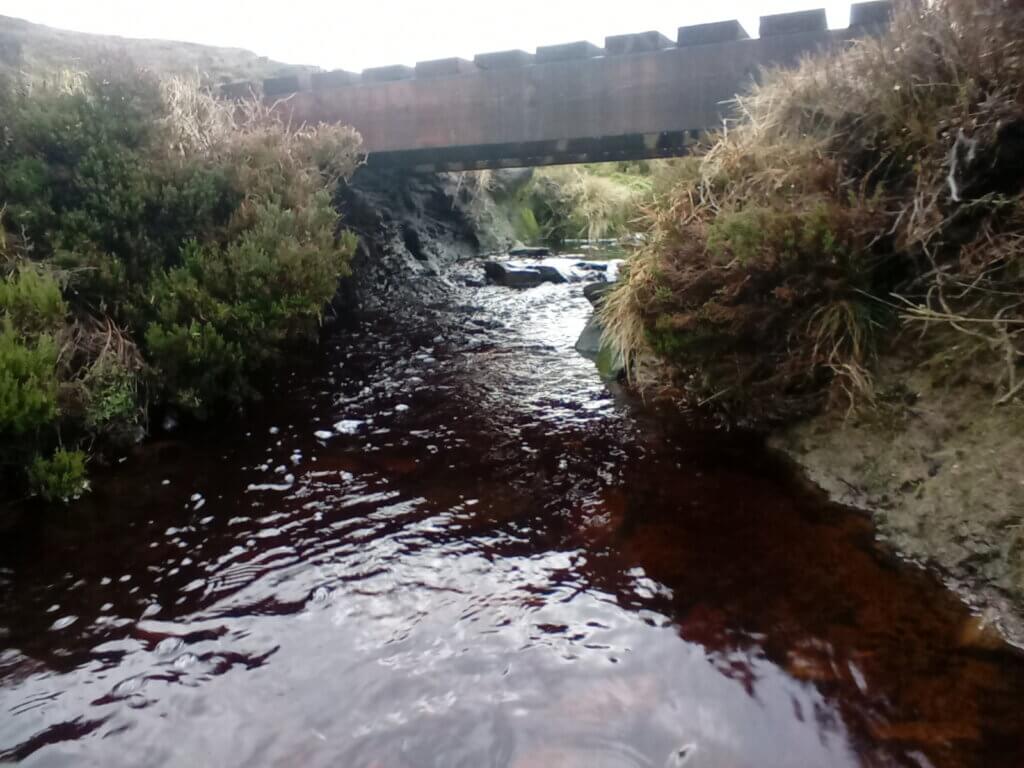
Woodhead Reservoir lies about a mile downstream from this image. Water colour is measured in units of Hazen and the average colouration at the reservoir increased from 90 Hazen to 110 Hazen between 2009 and 2017 – over 5 times the permitted level. It’s probably no coincidence that moorland burning significantly increased over this period as well.
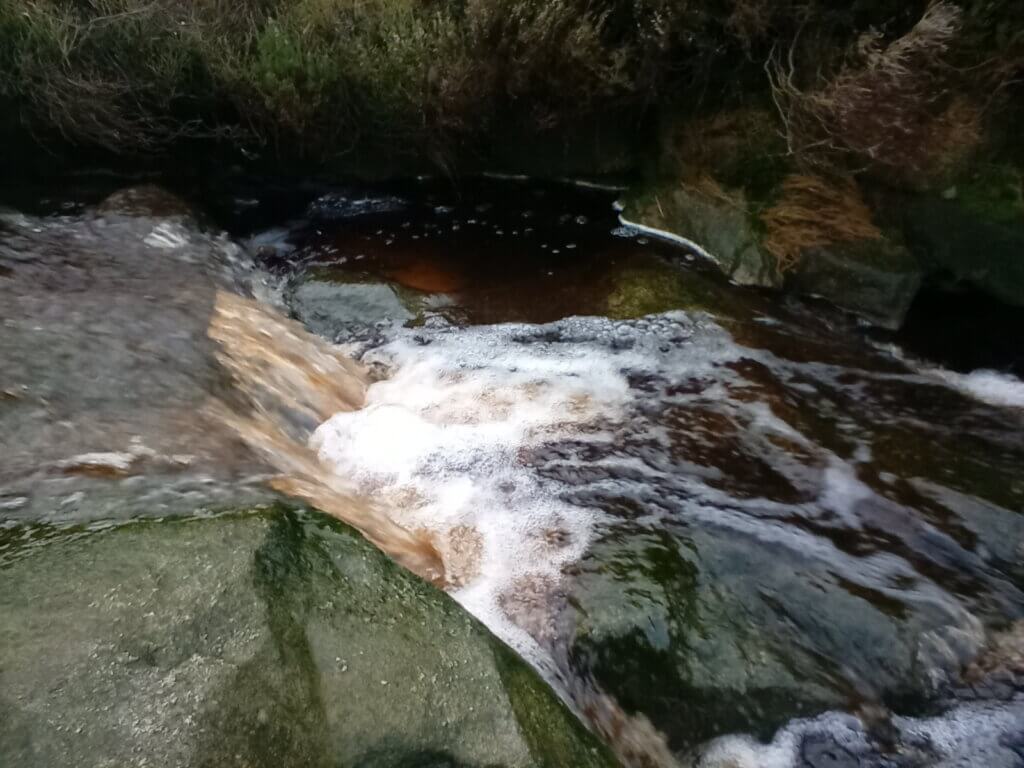
This is a cost to us all. The water from Woodhead Reservoir soon finds its way to Arnfield Water Treatment Works where an expensive and chemical intense process attempts to reduce levels of Colour. But “DOC can interact with chlorine (added to disinfect and protect the water in the distribution network) and result in the formation of by products including tri-halomethanes (THMs)” and these “have been associated with negative health effects such as cancer and adverse reproductive outcomes.” Normal “Chemical treatment consists of lime, ferric and a starch polymer.” A glass of water will never be the same again! And “the sludge is transferred to the adjacent Arnfield sludge treatment works where it is thickened and pressed and disposed of to land off catchment.”
So it’s no surprise that “water discolouration is expensive and energy intensive to treat to drinking water standards.” It’s us the public that pays for all this work via our water bills. Ten years into a restoration project it’s criminal that Natural England allows this estate to abuse and damage a protected landscape for the sake of commercial gain. The photos I’ve shown here are not selective: the damage is completely obvious to anyone who visits this site – if only Natural England officers would do this?
Finally any new infrastructure on a protected site in the National Park needs consent from Natural England as well as compliance with Planning Regulations. This very new looking bridge and stone slab footpath at Black Cabin doesn’t link with any existing path network and provides no benefit to the public. It does of course go to a line of shooting butts. Looks like I’ve got some emails to write….
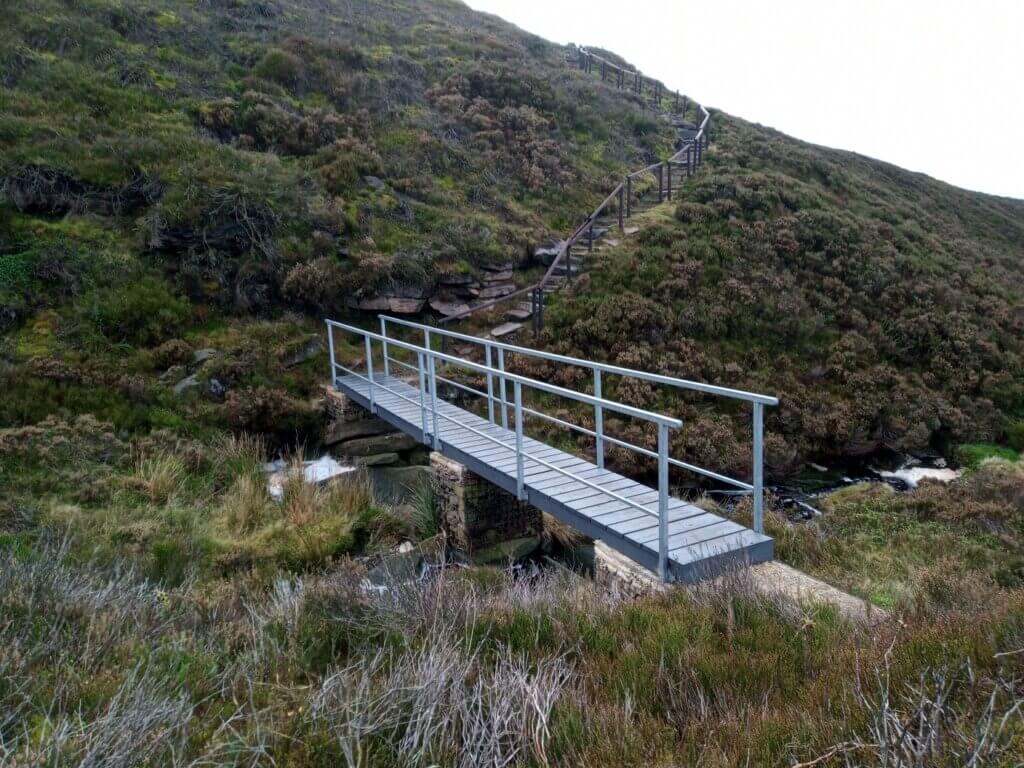
Absolutely disgraceful that Natural England are not doing their job, but this is no doubt because they have been starved of funds by this Government. It just highlights the rubbish that Johnson talks when he says there will be more protected areas such as National Parks. On the ground National Parks in this country protect almost nothing certainly not nature and wildlife.
Now if this wretched Government increased Natural England’s budget ten fold we might start to see some improvements to our wildlife.
By the way I visited a local SSSI chalk grassland yesterday and before I had got through the latched gate leading into it I counted five pheasants.
Despite all its words effectively this Government is doing absolutely nothing to halt the devastating effects the shooting industry is having on our nature and wildlife.
These places are not alone in being damaged, one might say abused in this way. There are many many grouse moors out there covering much of our uplands from the Peak district to the Scottish border and many if not most will have on them this sort of commercial damage for the “benefit” of grouse shooting. We need a watch dog with teeth, bloody big teeth and the financial and personnel to tackle this wholesale abuse of our heritage.
Bob, this is a great article but, as usual on here, you are preaching to the converted. Would you consider sending this to the environmental editor of the Guardian?
Hi Paul. Yes I’d be happy to do that. If any readers have contact details of journalists or even better could do an introduction then message me (after mutual following) on Twitter. Thanks
Try this lady?
Twitter: @sloumarsh
Instagram: sarah_marsh_journalist
Email: [email protected]
But what are these poor Estates to do in order to enable their keepers to get around? Surely a fit young keeper cannot be expected to leave his Hilux or his quad at home, and dare I say it walk 4 or 5 miles every single day, like the old boys used to do. Joking aside, one of the big factors these days is the constant carting about the moors of heavy bags of grit, how many miles and man-hours on the quad must this add up to I wonder?